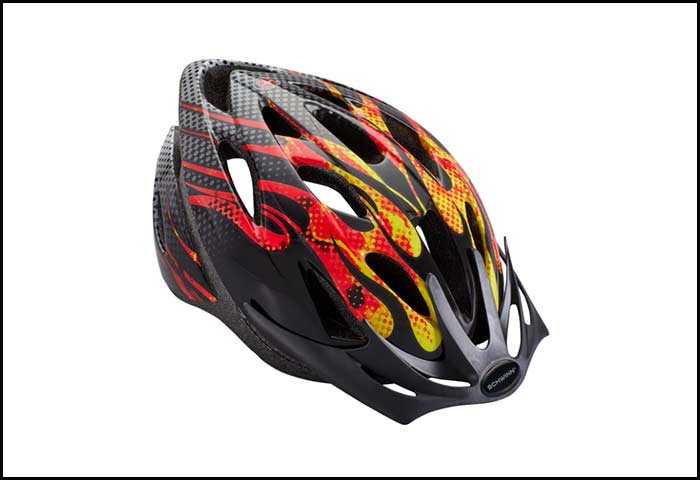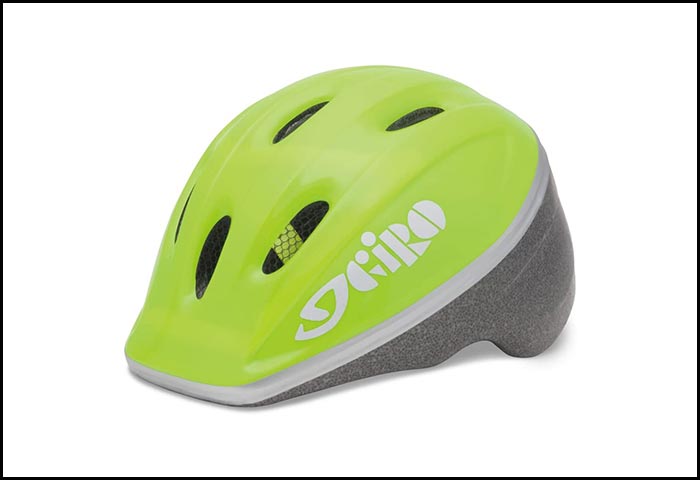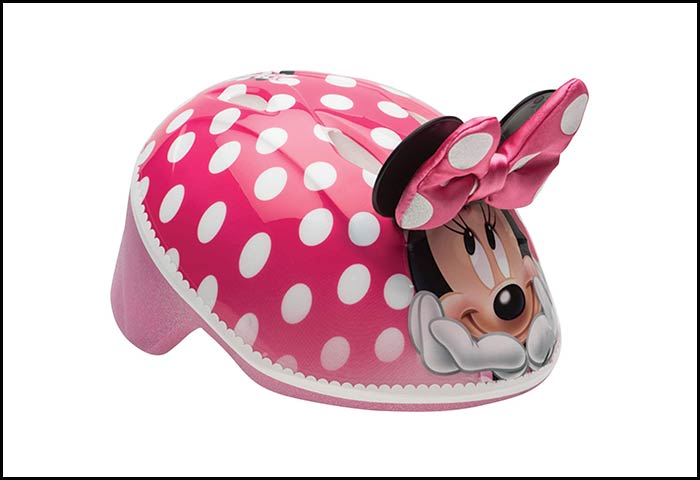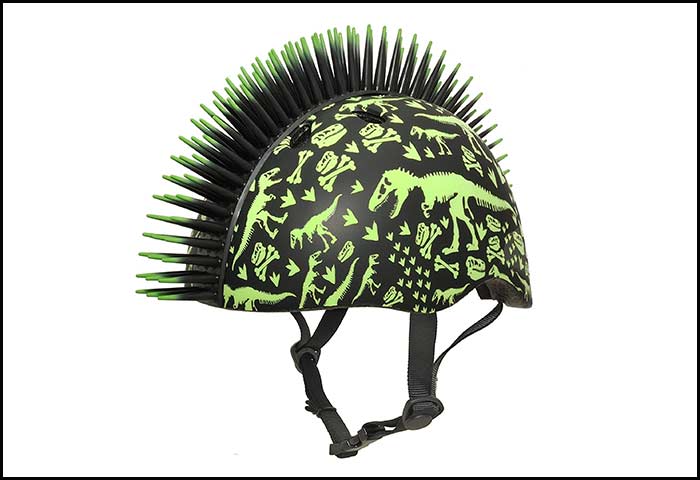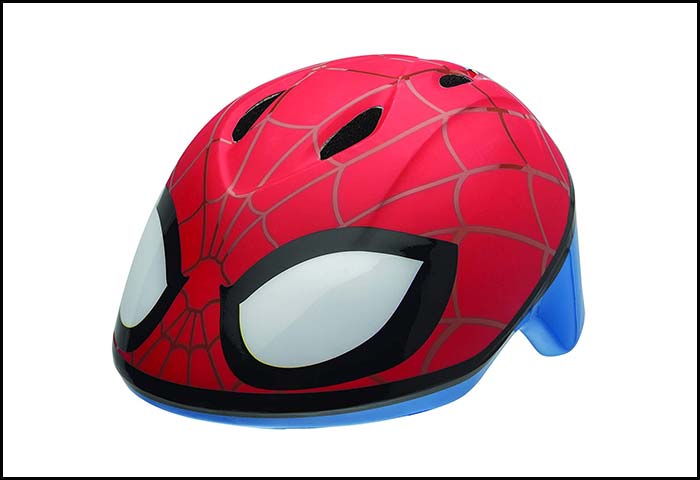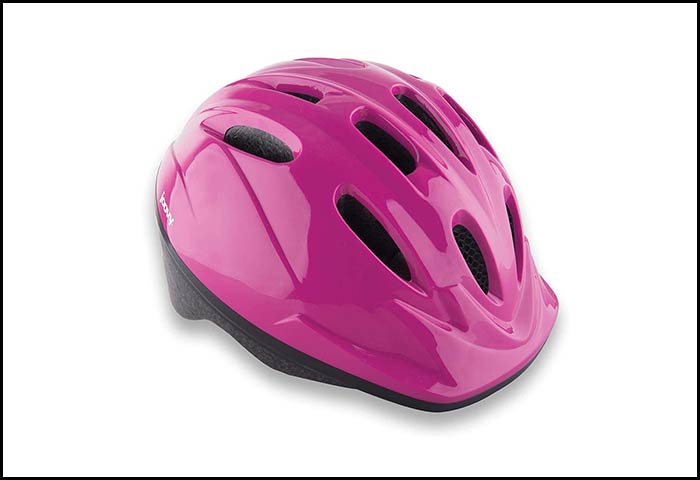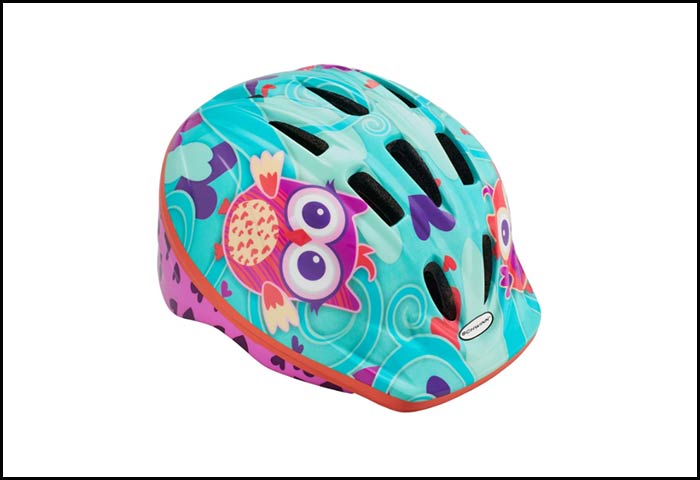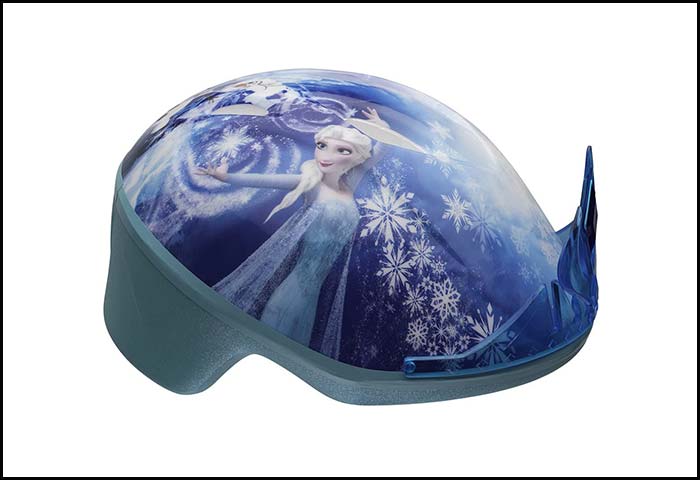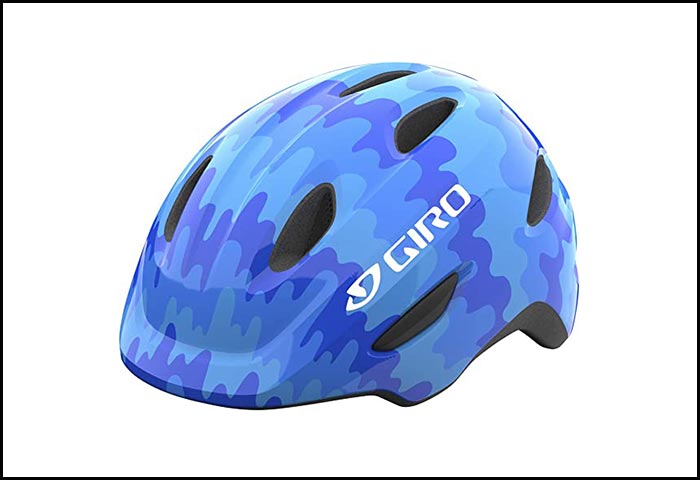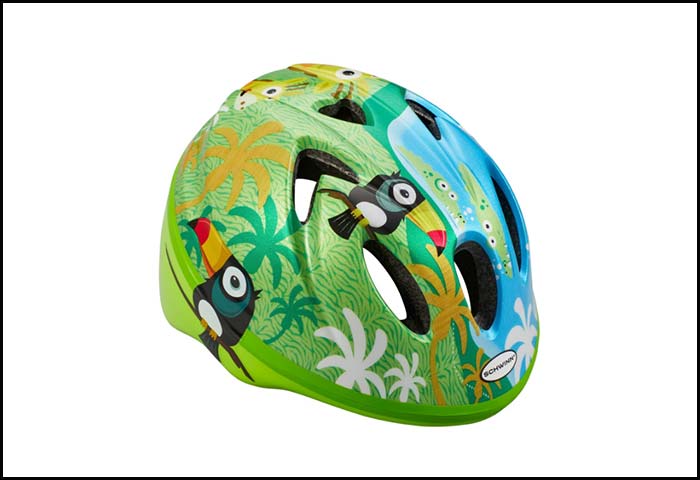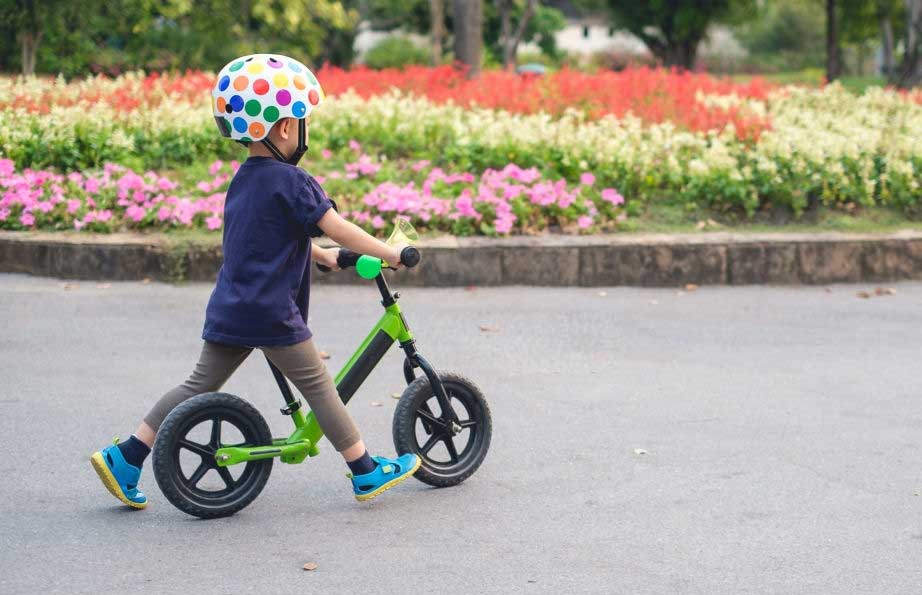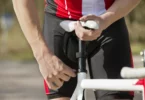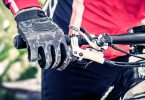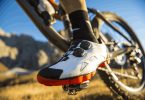Here we’ve thoroughly reviewed the best toddler helmets so you can easily make the right buying decision.
When our first child was born, he was full of life and we noticed the spirit of a pro biker in him. On his first birthday, he got his first biking experience sitting on the baby seat while his mom pushed the wheels. Though he loved bikes since his early years, our priority was his safety, and finding a perfect helmet for him seemed like a challenging task.
It took a while but we found the right headgear. However, toddlers go through a stage of tremendous neuro-transformation due to the fast growth rate of neurons in their brains. You can bet it’s the most crucial time for their mental development and, you’d do anything to protect their heads– and ideally, going for the best toddler helmet is the right decision to make if you plan to put your baby on a bike.
Today, we’ve put up this baby helmet buying guide to save you from getting lost in the myriad of models available on the market. Hopefully, our research-backed helmet reviews would help keep your child safe and sound when riding his/her lovely toddler’s bike.
Best Toddler Helmet Reviews
1 Schwinn Thrasher Lightweight (Our Top Pick)
Why Did We Give It the First Place?
When considering the features of a healthful toddler helmet, the Schwinn Thrasher had the highest number. Its outstanding qualities include stylish design, dial fit, easy adjustability, padding, lightweight, and much more. Looking at its rating on Amazon, we found that it had 4623 user ratings and received 4.6 stars. This score was a great indication of its popularity and quality over other items on this list.
Detailed review
The Schwinn Thrasher boasts of a superior design that most children and parents will always appreciate. Our favorite spec was the plenty of air inlets that allow your child to feel relaxed when riding in hot weather. So, if your child hated the previous headgear because of heat and discomfort, this one with 20 holes might be the solution.
Whether you want a matching outfit or your baby is picky with colors, there are several options to choose from that your young one will love. The interior has heat-sealed pads to ensure absolute protection, comfort, and a secure fit. This helmet covers the entire skull, such that the wearer’s brain won’t suffer from severe injuries in the event of a fall.
This helmet features simple adjustable side straps that make it easier to put on while keeping it secure on your child’s head. Besides, it comes with a detachable visor to protect your kid’s face from the sun’s glare.
The Schwinn Thrasher was a win-win for us, especially that it was super durable and fitted various head sizes ranging from 19.63 to 22 inches. However, it wasn’t ASTM F1492 Certified, implying you’ll only use it for biking.
It complies with the CPSC standards, meaning you can trust your child’s safety with it. With a reasonable price tag, it offers more than you can imagine when compared with most models for sale.
Pros
- Great fit and excellent protection
- Available in many color options
- Pretty adjustable
- Plenty of vents
- CPSC Certified
Cons
- Lacks ASTM F1492 Certification
Our Verdict
If you’re looking for a perfect toddler helmet (age range- 5 to 8 years old) at a comfortable price, the Schwinn Thrasher is the right deal for you. The features are amazing, especially the 20 vents for cooling; you can always trust your child’s safety with it.
2 Giro Me2 (With Full Safety Features)
The Giro M2 is the smartest choice to make when keeping an infant in mind. Unlike our top pick, which is pretty big for small kids (age range- 2 years to 3 and a half years), this one fits heads measuring 18.75 to 20.5 inches. It has many funny and exciting paintings to motivate your child to gear-up.
Its most significant winning point is the Giro’s Mini-Loc system that’s pretty easy to adjust while the simple strap guide helps to prevent skin-pinching. Besides, the dial adjustment knob allows your child to enjoy a snug fit while growing with the helmet.
It’s six air holes have nets that keeps-off insects but allows free-flow of breeze, keeping your baby fresh. Though the Giro M2 didn’t have many air vents as our first choice, it featured thick interior padding and a built-in visor for your toddler’s safety and comfort even if it’s on a quad bike.
However, we noticed that a couple of users complained about the tendency of the plastic strap to detach from the helmet when riding with your child, and since we didn’t expect everything to be perfect, it wasn’t a deal-breaker for us.
Pros
- Fanciful designs
- Quick and easy to strap
- Pinch-free buckle
- Dual-adjustment strap
- Perfect for infants
Cons
- Plastic attachment part may fall out with the use
Our Verdict
This helmet is what you need for your young ones below the age of 5. The features are merely innovative, making the price pretty worth it.
3 Bell Disney Minnie Mouse Bike Helmets (Pretty Looking)
This Bell Disney item is for real the cutest baby helmet on this list. It’s available in many designs, and top of the list is the one with 3D Minnie with ears which your baby will always adore. Like our previous choices, it features side straps with flat buckles that allow you to clip on before hitting the roads quickly.
The sizes range from 3 – 5 years, 5 – 8 years, and women aged 14+, so you can quickly select the one that suits your preference. This helmet didn’t come with an adjustable dial at the back, though that wasn’t a problem for us since the side straps offered the right fit.
However, our only concern was that it didn’t have holes for ventilation that made it unsuitable for the hot weather. Looking into its pretty looks, sturdy build, availability in different colors and sizes, we feel that this Bell Disney model will be an excellent accessory for your kid’s tricycle.
Pros
- Multiple sizes
- 3D designs and colors
- Built-in visor
- Extended coverage
Cons
- Poor ventilation
Our Verdict
This model is available in different sizes to suit your child’s head circumference while the dual side straps provide the perfect fit. Besides its sturdy build keeps your baby safe during a crash, the 3D designs are merely appealing to the eye.
4 Raskullz Digital Camo Mohawk (Funny Looking)
If you’re looking for a helmet with printed graphics that’ll inspire your children’s imagination of various wild animals, this Raskullz Digital Camo is for you. It features a 3D bendable Mohawk that gives it a thrilling and funny look. This Mohawk is from a high-quality thermoplastic rubber that is non-toxic, yet durable, lightweight, and soft to the touch. Talking about weight, this one is the lightest on this list, weighing just 0.16 ounces, meaning it’ll be like there’s nothing on the head.
Compared to our third choice that lacks air vents, this one has holes to keep your baby chill. The inner shell is from EPS (Expanded Polystyrene) to absorb shocks upon collision. Besides, the tank is filled with a soft material to give your child a comfortable feel when wearing for long hours.
This Raskullz model didn’t have a dial knob at the back, but the sliders at the straps ensure that you’ll enjoy the perfect fit for your head. While this item will make your toddler stand out from the crowd, it has both CPSC and ASTM certifications, so your child is protected.
We love almost everything about this product other than the lack of padding on the chin strap that may make you feel uncomfortable.
Pros
- Affordable
- EPS shell
- CPSC and ASTM certified
- Inspiring graphics
- Lightweight
Cons
- Straps not padded
- No dial for a custom fit
Our Verdict
This item is designed to protect your baby’s head while turning the heads of other road users while riding with your child. The 3D Mohawk and dinosaur designs are merely fantastic, creating a whole new world in your toddler’s thoughts. Looking at the price and splendid features, this is an excellent deal.
5 Bell Marvel Avengers Character Bike Helmets
Bell helmets classy and stylish design always gives your child that unique look when riding their kid’s bike. This one is a recreation of the Spiderman series to make the baby feel like the hero when cruising around the neighborhood. It’s also available in various designs and sizes for you to choose depending on your toddler’s age.
This product features six air outlets for cooling; each of the holes has nets to keep off bugs. Also, the buckle is pinch-free and easy to adjust, giving the perfect fit and comfort.
About the price, the item is sold between $18 to $60 depending on the type you select. Though the helmet’s design was great, the only issues were the lack of visor and fitting problems. However, this wasn’t a big issue for us since only a few had that experience.
Pros
- Great quality
- Exciting design
- Available in other sizes
- Netted vents
Cons
- Not true to size
Our Verdict
This is definitely one of the best toddler bike helmets designed to offer the best fit and comfort. We strongly appreciated the Superman design which provokes the feeling of heroism in your child. The pinch-free buckling and impact reflectors allow other road users to see your child under poor lighting conditions. Looking at these features, this model was worth more than its cost price.
6 Joovy Noodle Bike Helmet for Toddlers
Safety always tops the list of the factors to consider when shopping for the best toddler helmet, but one important feature to look out for is if the headgear’s style and design suit your child’s gender. Having this in mind, the Joovy Noodle Helmet is developed only for baby girls.
It’s made with high-quality materials, making it rock solid to secure your child’s head upon impact. It has thick pads for cushioning as well as 14 air vents to keep your girl comfortable as each of the holes has nets to prevent bugs from hitting your child during the ride. The straps are secured to the helmet to prevent it from pulling out during an accident.
Like our 3rd choice, this Joovy helmet features a dial button at the back for you to adjust depending on your child’s head size. Besides, the straps have soft pads to prevent skin irritations, which could mar the fun. It’s available in black, blue, purple, pink, Elmo orange, red, and green color options.
Unlike our first choice, this one comes with an extended visor to offer your toddler extra protection from the sun’s scorching heat. Besides meeting CPSC standards, this model costs a little under $30, making it a great choice for the money that won’t disappoint you in any way.
This helmet’s coverage is merely fantastic. It protects the entire skull and also extends to the base of the head. It comes in small and medium sizes, making it a reliable option for kids aged 1 to 4.
Pros
- Solid construction
- Padded straps
- 14 air vents
- CPSC approved
- Adjustable dial
Cons
- Only suitable for children aged under 5
Our Verdict
The Joovy Noodle helmet trends on the market for many good reasons. It’s lightweight, affordable, and delivers a perfect fit on the head. While most parents choose it for their girl child, this helmet looks good too on boys.
7 Schwinn Kids Bike Helmet
The Schwinn is another brand you can always trust when looking for the safest kids helmet to buy. What we liked most about this product was the lightweight construction and beautiful designs that made it appealing for both young boys and girls. It weighed at 8.6 ounces, making it the lightest we’ve got on this list.
What’s more, it has a dial that provides 360-degree adjustability for you to customize your child’s fit easily. It features the lower molded shell for better protection against damage in the event of a crash.
Also, there are six ventilation holes to keep your child relaxed. Though the number of vents is small when compared to our first choice, the slots are more massive for the passage of more air.
However, this Schwinn model is retailed at around $20 – one of the cheapest on this list. Though the manufacturer recommends it for children aged above two years and under 3 years of age, we found that it did fit a five-month-old infant after we tightened the straps.
Pros
- Ultra-lightweight
- 360-degree dial
- Lower molded shell
- Easy to adjust
- Adorable designs
Cons
- Slight issues with fit
Our Verdict
When looking for a reliable infant helmet, it’s hard to deny that the Schwinn model is the perfect option for you. It will help you save a few bucks while keeping your baby safe on a balance bike.
8 Disney Frozen Bike Helmets for Child and Toddler
The Bell Company pretty knows how to appeal to your child’s imaginations. Having what your child fancies most in mind, this model features the most famous Disney characters. Of course, your child will love to gear up when these figures are on their headcover.
This helmet measures 8-inches front to back; 6 ¼ inches to the sides. The circumference is almost 22.5 inches, making it a perfect choice for children aged 3 to 5 years. It has padding that covers the entire head and also provides a cushion for the forehead.
Pros
- Disney characters
- High-quality build
- Extended coverage
- Excellent padding
Cons
- Issues with the fit
Our Verdict
The helmet looks good and made from Bell, which is known for her top-quality products. It features the True Fit system, which is like an elastic band, making it a little substandard when compared to other models from this Company. The price is commendable, only that you’ll pay more for the bigger sizes.
9 Giro Scamp Youth Recreational Cycling Helmet
The Giro Scamp Helmet has almost all the top-notch features you’ll find in an adult headgear. Its most significant feature is the patented Roc Loc Jr. fit technology for the absolute alignment of the helmet with your baby’s head. Also, it comes with a dial adjustment knob that makes it securely stay even on the smallest heads.
Like the Joovy Noodle model, the Giro Scamp is available in both extra-small and small sizes for you to quickly choose the right fit for your toddler’s head circumference.
In terms of construction, it uses an in-mold polycarbonate shell for superb impact resistance and durability. Besides, your child can always feel safe and comfortable thanks to the padded inside and pinch-free guard buckle.
The price range is between $25 to $70 depending on the size you pick, which is excellent for a toddler headgear having elements found in many best-rated adult helmets.
It received 4.7 stars from 482 ratings at the time of the writing. All of our kids felt good in this helmet, though it was a little more expensive than our previous choices.
Pros
- Roc. Loc. Jr fit
- Hardshell
- Padded inside
- Built-in visor
- Many color options
- High rating
Cons
- Relatively expensive
Our Verdict
The Giro Scamp helmet has the highest score on this list, which indicates its high-quality construction and comfort. Though its price is a little on the upper side, depending on the selection, it’s worth the money.
10 Schwinn Kids Bike Helmet Classic Design
This product is another big hit to consider when searching for the best bike helmets for infants. This Jungle model from Schwinn a dial fit at the back, making it comfortable for both large and small heads. There’s also a built-in visor to shade your baby from the sun.
Unlike our top pick with 20 with vents, this one has six holes large at the top to keep your little one’s head fresh. Besides, it features a lower molded shell to protect your child from fatal head injuries following a fall. In all, we liked this helmet, and the padding inside felt pretty comfortable.
Our only dissatisfaction with this model was its lack of pinch-free buckle, meaning that babies with sensitive skins would feel uncomfortable in it.
Pros
- Visor
- Extended rear coverage
- Eye-catchy design
- Lower molded shell
- 6 large vents
- Internal padding
Cons
- Not ideal for babies with sensitive skin
Our Verdict
Nice helmet, perfect for children aged 1year to 5 years. Dial at the back allows you to adjust the fit to your taste while the internal paddings give you excellent comfort. The good news is that it’s among the cheapest on sale, so you won’t break the bank before buying it.
Why Do You Need a Bike Helmet For Your Kid?
Helmets help protect your child’s head absorbing the impact during a fall or crash while riding a bike. Of course, falling isn’t a big deal, it’s part of the learning process. We learn walking by falling first. But the issue is keeping your young ones safe from skull injuries.
Putting on a helmet is so crucial that most US states made it compulsory for everyone. At the same time, the Federal government created its safety rules under the Consumer Product Safety Commission (CPSC).
Headgear can protect your baby’s head and face from the sun’s scorching heat, especially when you’re on a distant journey. Besides, your child looks confident and beautiful when wearing an eye-catchy helmet.
Though accidents occur, a toddler helmet is necessarily a lifesaver that every pediatrician recommends. You’ll spend less on medical bills if your child falls off or crashes on a bike while wearing a good helmet.
Best Toddler Helmet [A Comprehensive Buying Guide]
1. Safety
Keeping your child safe is an essential thing to have in mind. The material for the helmet should be sturdy enough to withstand the crash impact and also protect the baby’s head. The product should meet the minimum safety standards for skating or bicycle use. So, always check the CPSC or DOT certification sticker before buying.
2. Fit
The helmet should have a perfect fit, reaching the child’s forehead. It should be snug but also tight to prevent it from coming off when an accident happens. A snugly fit helmet is always important if a kid rides a BMX bike.
3. Size
Generally, helmets aren’t a one size fit for all. So measuring your child’s head circumference is always the best option before purchasing a headcover. You should measure a little above the ears and across the forehead since the manufacturers often concentrate on these spots. Most helmets in this category are micro in size and have adjustable straps.
You can choose one with an adjustable dial in the interest of your growing toddler; this will help save a few bucks.
4. Design
Baby helmets are available in either the skates or standard models.
- Skates –They have better paddings and coverage for a higher level of protection. Since skates have harder shells, your child may feel uncomfortable when resting their head on the bike seat, so always opt for one with a flat back.
- Standard – Compared to skates, these have more holes, but only available in smaller sizes.
5. Ventilation
Helmets with many air vents help to keep the baby cool and comfortable. If you want your child to enjoy the ride, and wear the headgear for longer hours, choose one with adequate ventilation. Full-faced helmets offer less ventilation but better protection with an extra face shield and chin guard.
6. Comfort
The helmet’s inner foam core should have enough cushioning to keep the child comfortable during the ride.
7. Age
You should start hunting for the best toddler helmet only when your child is ready. Your kid’s neck muscles should have enough strength to bear the load. Though it depends on the growth rate, 8-month-olds usually could start wearing headgear. Theoretically, toddler’s helmets are ideal for babies aged below 4 years of age, but some models can fit ages above that range.
8. Adjustability & Buckle Type
Since helmets vary in size, always look for those with adjustable features like straps and dial to provide the perfect fit. The buckles should be easy to adjust and less likely to hurt the baby. Most toddlers’ helmets have ratchet or magnetic style buckles that will not easily pinch.
9. Weight
Consider buying a lightweight helmet since your child’s neck muscles are too weak for a large type. The lighter the weight, the lesser the pressure on your baby. Most children dislike helmets because they’re heavy and feel quite uncomfortable.
10. MIPS
Helmets with the MIPS technology provide extra protection and safety for your young one. MIPS features a plastic layer that rotates during impact to protect the child’s head from fatal injuries.
11. Brand
Though the top-rated biking helmets are obviously expensive, you shouldn’t trade your child’s safety and comfort over money. So, look for those reputable brands that you can always trust.
12. Visors
Most bike helmets for infants have built-in or clip-on visors that protect your kid’s eyes and face from direct sunlight, making the riding more appealing.
It’s Time to Wrap Up
The helmets on this toddler helmet review are the trendiest among both parents and kids. After careful research and field-tests, we’ve picked the best toddler helmets from hundreds of choices on the market.
These helmets are essential for your baby’s safety and comfort when biking or skating; that’s the reason we’ve gathered only the best-rated models to ease your buying decision.
Our most favorite toddler helmet was the Schwinn Thrasher because of its many crucial features. It had 20 vents for cooling, ergonomic interior padding, and complies with CPSC standards.
If you’re on a limited budget, but looking for products with amazing designs, you might consider the Raskullz and Bell models.
Feel free to choose any of our products that suit your pocket and preferences.
FAQs
1. What is EPS?
Ans. Expanded Polystyrene or EPS is a rigid and lightweight foam often used as the primary material for helmets and picnic coolers.
2. What is MIPS?
Ans. MIPS stands for Multi-Directional Impact Protection System. This is an extra safety feature often found in expensive headgear models. It allows the helmet to absorb the impact from the crash despite the direction of hit and, in turn, reduces brain injury. The design consists of a unique plastic core that attaches to the outer helmet via a rubberized cord. During a crash, the base expands, causing the foam layer to rotate to dissipate the impact’s energy.
3. Should I put a helmet rated for a one-year-old on my eight-month-old?
Ans: Most toddler helmets are for one-year-olds. However, the head size of kids differs and your focus should be on finding the right fit for your child.
4. How can I tell if my child’s helmet fits correctly?
Ans: The helmet should have a snug fit, allowing your child’s eyebrow to move when you’re trying to shift it from the head. Another correct fit indicator is that the chin strap should be tight when your baby’s mouth is open and loose when closed. Finally, the helmet should cover the skull to the top of the ear and the middle of the forehead.
5. What’s the difference between traditional helmets and multi-use helmets?
Ans: Your kid will feel more comfortable in traditional bike helmets since they have more vents than the multipurpose type. However, multi-sport helmets like the Nutcase – Little Nutty Bike Helmet often have CPSC and ASTM F1492 certifications, meaning that you can use them on a bike, skateboard, scooter, etc. Also, they’re more durable, offering secure fit, comfort, and protection for the kid’s head.
6. What’s the difference between in-mold and hardshell construction?
Ans: Each helmet features an EPS core and an outer shell layer. Most bike helmets have in-mold construction where the foam core and the lightweight plastic layer are fused. In Hardshells, the plastic layers are thick such that the EPS foam is only glued to it.
7. What’s the difference between CPSC and ASTM certification?
Ans: The Consumer Product Safety Commission (CPSC) is a US government agency that is saddled with the responsibility of outlining the safety rules and standards for bike helmets. The American Society for Testing and Materials (ASTM) is an independent organization that tests and certifies all multi-functional helmets.
8. Should I look for a helmet with a flat back if I’m going to use a bike carrier instead of a trailer?
Ans: Helmets with flat backs allow your children to rest their head while sitting on the bike carrier or trailer while preventing the mask from slipping off when they want to rest on the trailer. Also, babies wearing flat back head covers will enjoy a better view of the environment.
9. Is the magnetic buckle on a helmet safe for my baby?
Ans: Magnetic buckles are the easiest to use, but most children often play with them during their rides and could loosen the fit. Besides, they fit more securely and don’t pinch the user’s skin like most traditional buckles.

